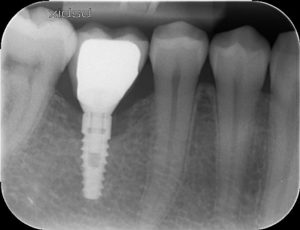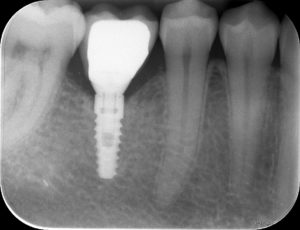Our case of the month for July is an unusual one in the sense that we are not highlighting a wonderful new smile , straighter teeth, whiter teeth or a fantastic new technology.
This month, our focus is on peri-implantitis. Now you may wonder what on earth is peri-implantitis. Well, we can report that peri-implantitis is becoming a major issue in relation to dental implants and the prevalence will only increase as more and more dental implants are placed.
Definition
Peri-implantitis is an inflammatory process affecting the soft and hard tissues surrounding an implant. This disease is associated with loss of supporting bone, bleeding on probing, and occasionally suppuration (pus exudate). The cause of peri-implantitis is complicated and relates to a variety of factors that affect the implant . In general peri-implantitis can be influenced by three factors:
- Patient-related factors including systemic diseases (e.g, diabetes, osteoporosis) and prior dental history such gum disease
- Social factors such as poor oral hygiene, smoking, and drug abuse
- Parafunctional habits such as bruxism which is another huge modern day problem
In addition to the above, we dentists must also accept responsibility in some cases due to issues such as faulty restorations, cement excess beyond the crown margin and loose components such as screws which have not been torqued to a high enough level.
Case Details
Our case presented with a dental implant that was bleeding and suffered from very deep pockets around the entire dental implant. The gum tissue around the implant was also very swollen and inflamed. An x ray highlights the level of bone loss :
The implant was placed in another country about 5 years ago. The type of restoration was a cement retained crown. As mentioned above, excess cement lodged within the tissue can be the primary cause of peri implantitis and this was the case here. We removed the crown and found a large amount of cement within the sulcus. This was cleaned and the Waterlase i Plus dental laser was used to clean the implant threads which is far superior than normal ultrasonic cleaning or hand scaling using titanium instruments. The Epic 10 diode laser was used for bio stimulation using low level laser therapy to encourage blood flow and healing. After thorough post operative instructions and after care, another x ray was taken to evaluate the response:
A superb result. The bone levels are now back to normal with in fill of the dark voids seen on the first x ray.
Summary
Peri-implantitis is a rising issue and will continue to rise as dental implants become the first choice replacement for missing teeth. With a full and thorough assessment and diagnosis, there are treatment modalities that can help and even reverse the hard and soft tissue loss caused.
Article written by Dr Nissit Patel, Clinical Director, Progressive Dentistry, Fulham, London.



